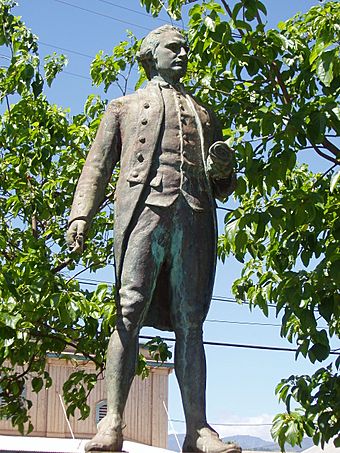Cook Landing Site (Waimea) facts for kids
|
Cook Landing Site
|
|

A monument near the site
|
|
| Location | Southwest of Route 50, Waimea, Hawaii |
|---|---|
| Area | less than one acre |
| Built | 1778 |
| NRHP reference No. | 66000298 |
Quick facts for kids Significant dates |
|
| Added to NRHP | October 15, 1966 |
| Designated NHL | December 29, 1962 |
The Cook Landing Site is a special historical place in Waimea, on Kauaʻi island in Hawaii. This is where Captain James Cook first arrived in Hawaii. He landed near the Waimea River on January 20, 1778.
Captain Cook was the first European explorer known to have seen the Hawaiian Islands. His landing on Kauaʻi was his very first time stepping onto Hawaiian soil. Because of its importance, the Cook Landing Site was named a National Historic Landmark on December 29, 1962. Today, you can find a monument to this event at Hofgaard Park, which is close to the landing spot.
Contents
Where is the Cook Landing Site?
The Cook Landing Site is located on the shore of Waimea Bay. This is in southwestern Kauaʻi, right next to the mouth of the Waimea River. No one knows the exact spot where Captain Cook landed. It's thought that the land might have changed since 1778. This is because of natural build-up of sand and dirt from the river.
The landing site is believed to be near Lucy Wright Park. It's also across the river from the old Russian Fort Elizabeth, which is now a state park. Hofgaard Park is a short walk inland from the shore. It has a statue of Captain Cook. You can also find special plaques there that tell about his landing.
Who was Captain Cook?
Captain James Cook (1728-1779) was a famous British Royal Navy officer. He is well known for his many voyages of discovery. He explored and mapped many parts of the world.
His third big trip took him into the Pacific Ocean. First, he explored islands in the South Pacific. Then, he sailed north towards the west coast of North America.
Cook's Arrival in Hawaii
On January 18, 1778, Captain Cook's ships saw the islands of Oahu and Kauaʻi. They sailed towards Kauaʻi with the wind. The next day, the ships sailed along Kauaʻi's eastern coast. Native Hawaiians came out in their canoes to meet them. They traded with the sailors.
Cook sent a team to find a good place to anchor. They found Waimea Bay to be a "tolerable" spot. So, he anchored his ships there on the afternoon of January 20. Many Native Hawaiians gathered on the sandy beach. Captain Cook came ashore with guards. They quickly became friends with the local people.
The next day, Cook explored the river valley. He wrote many detailed notes about the people and their culture. These notes are very important today for understanding Hawaiian history.
After the Landing
Cook's expedition stayed in the islands for two weeks. During this time, Captain Cook also explored Niʻihau. After their visit, the expedition continued to map the Pacific coast of North America. They sailed all the way to the Bering Strait.
Later, the expedition returned to what Cook had named the Sandwich Islands (Hawaii). Sadly, Captain Cook died in a conflict on the Big Island.
Images for kids




